Knighton is a small market town in the historic county of Radnorshire, situated on the River Teme and on the England – Wales border. Part of the town lies in Shropshire. The men of the town who fell during both World Wars are commemorated on a war memorial, in the form of a cenotaph, which is situated in the middle of the town square.
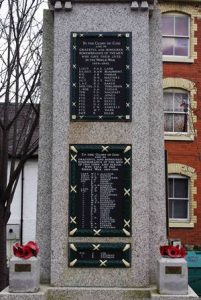
The Great War, 1914-1918
William Thomas Lloyd Allcock, Captain, Royal Flying Corps. William was born on 14 October 1896, the son of John Lloyd Allcock and Sarah Jane Allcock, of Bourne House, Knighton. He gained his pilots license at the Beatty School, Hendon on 16 May 1915 prior to being commissioned into the Royal Flying Corps on 12 June 1915 and was posted to 2 Squadron in France. The Squadron was equipped with the BE2c at Bethune. From February 1916 he flew with 16 Squadron at La Gorgue. From June to September 1916 he became an instructor in England but returned to France with 46 Squadron, which moved to Drogtland. He was shot down and wounded in November, so returned home to recuperate. When he returned to France he joined 40 Squadron at Bruay. The Squadron was equipped with the Nieuport 17 fighter. On 5 June 1917 William took off from Bruay flying a Nieuport 17, Serial B1548. He was never seen again. The 21-year-old has no known grave and is commemorated on the Arras Flying Memorial, France. He was posthumously Mentioned in Despatches by Sir Douglas Haig.
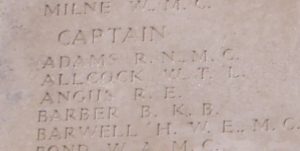
Harry Hickman Bromfield, DSO, Major, Welsh Guards. Harry was the son of Henry and Mary Elizabeth Bromfield, of Stratford-on-Avon. He married Ethel Philippa Philipps in 1906, the eldest daughter of Sir Charles and Lady Philipps of Picton Castle. Harry had served in the South African War as Captain in the South Wales Borderers, and had gained the Distinguished Service Order in South Africa for his gallant leadership. He had been the Chief Constable of Radnorshire Constabulary prior to the war and volunteered to serve with the newly formed Welsh Guards in 1915, joining the battalion at Esher. The 1st Battalion, Welsh Guards was attached to 3rd Guards Brigade, Guards Division, which had been formed in France in August 1915. It remained on the Western Front throughout the war and saw its first major action during the Battle of Loos on 25 September 1915, remaining in the area during the coming months, where they also fought in the subsequent Action of Hohenzollern Redoubt. In July 1916 the Division moved to the Somme, and Harry joined it here, when he took command of Prince of Wales Company from Viscount Clive, who had been promoted. On 14 August the battalion was relieved by the 2nd Battalion Scots Guards, and went into a variety of rest-huts, ruins, and trenches round Colincamps. The Guards then moved back into the line, taking over from 48 Brigade a line along the outskirts of the wood at the end of Ginchy. The situation at the time was a mess. The Welsh Guards were facing the wrong way, as they did not know what had happened during the previous attack, and in the ensuing fighting, Harry was killed while leading his men gallantly on 10 September 1916, aged 47. He is commemorated on the Thiepval Memorial, France. Harry is commemorated inside St. Edward’s Church, Knighton, and not on the main memorial.
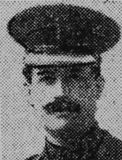
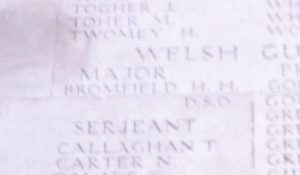
Richard William Bumford, Private, 78730, King’s (Liverpool Regiment). Richard was the son of Richard and Naomi Bumford, of 4, Mill Green, Knighton. He worked as a watch repairer prior to the war. He enlisted at Knighton into the army and was posted to France, joining the 26th Labour Company, King’s (Liverpool Regiment). Richard had been in France less than a month before he took ill and died of pneumonia on 4 April 1917, aged 38. He is buried in Boulogne Eastern Cemetery, France.
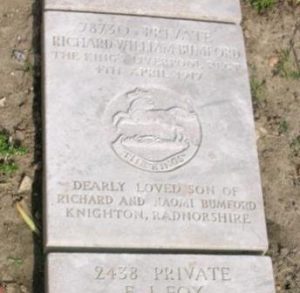
Frank Reginald Cooper, Private, 2066, Montgomeryshire Yeomanry. Frank was born in Knighton in 1876, the son of Caroline Cooper. He worked as a Drapers Assistant prior to the war. Frank enlisted at Knighton into the Montgomeryshire Yeomanry and was posted to their 2nd/1st Battalion, which formed at Welshpool in September 1914. He took ill soon after enlisting and was diagnosed as suffering from tuberculosis, so was sent to the West Wales Sanatorium in Llanybydder, where he died on 23 March 1915, aged 38. His remains were brought home for burial in Knighton Cemetery.
Joseph Cox, Private, 27705, South Wales Borderers. Joseph was born illegitimately at Presteigne on 19 February 1900, the son of Miriam Hollings Cox (nee Bridges), who died a week after his birth. He was raised by John and Annie Edwards at Presteigne before being adopted by George and Annie Allerdyce of Childs Alley, Knighton. Joseph enlisted at Knighton into the South Wales Borderers early in the war and was posted to France late in 1916, joining the 1st Battalion, South Wales Borderers, which was attached to 3 Brigade, 1st Division. The Division followed the German retreat to the Hindenburg Line in early 1917, before moving to the Flanders Coast during the summer of 1917. In the meantime, the Third Battle of Ypres had stalled in the mire, and the Division was recalled to Ypres, where it fought at the Second Battle of Passchendaele. After spending another Winter in Flanders, the Division was near Estaires when it became caught up in the German Spring Offensive. Joseph was wounded at some time afterwards and was evacuated to the 13th General Hospital, Boulogne, where he died of his wounds on 30 July 1918, aged 18. He is buried in Terlincthun British Cemetery, Wimille, France.
Ernest Llewellyn Cross, Corporal, 25152, Manchester Regiment. Ernest was born at Chinley, Derbyshire in 1879, the son of Ernest and Lucy Cross. He married Lucretia Elizabeth Irwin, of Belle Vue, Shrewsbury, on 5 February 1908 and the couple moved to 8, Broad Street, Knighton, where their son Ernest was born the following year. Ernest worked as a Chemist and Pharmacist at Knighton prior to enlisting into the 26th Reserve Battalion, Manchester Regiment at Knighton on 20 November 1915. He was mobilised on 21 June 1916 and posted to France on 7 March 1918, with the 2/7th Battalion, Manchester Regiment. The battalion was attached to 199 Brigade, 66th Division and moved to the Somme sector. On 21 March 1918 the Germans launched the first phase of their Spring Offensive in the Somme sector and hot the British lines at dawn, under cover of thick fog. Ernest was killed during the heavy fighting that day. The 39-year-old has no known grave and is commemorated on the Pozieres Memorial, France.
William James Davenport, Private, 355055, Royal Welsh Fusiliers. William was the son of William and Helen Davenport, of 31, Market Street, Knighton. He worked as a bricklayer prior to enlisting at Knighton into the Montgomeryshire Yeomanry on 24 February 1912. He attended the summer Yeomanry camp over the coming years, and after the outbreak of war was embodied on 5 August 1914, joining the battalion at Welshpool. The battalion was attached to the South Wales Mounted Brigade and moved to Hereford before entraining for Thetford, joining the 1st Mounted Division in September 1915. The Division then moved to Cromer where it was dismounted and on 4 March 1916 sailed from Devonport for Egypt. After spending a year on the Suez Canal defences, in March 1917 the Montgomeryshire Yeomanry merged with the Welsh Horse at Helmia to form the 25th (Montgomery & Welsh Horse Yeomanry) Battalion, Royal Welsh Fusiliers in 231 Brigade, 74th (Yeomanry) Division. The Division then took part in the Palestinian offensive with the EEF and took part in the Second and Third Battles of Gaza, before moving towards Jerusalem. By the start of December 1917, the Division was moving towards the Zeitun Ridge, getting in position to attack Jerusalem. William was killed on 8 December 1917, during the final advance to take the heights over Jerusalem. He was 24 years old and is buried in Jerusalem War Cemetery, Italy.
Arthur Davies, Private, 4926, Herefordshire Regiment. Arthur lived at Station Road, Knighton. He had served with the South Wales Borderers prior to the war, and then during the Great War had served with the Herefordshire Regiment. Very little else is known of him, but he died at Knighton on 2 May 1919, aged 40 and was buried in Knighton Cemetery. He is commemorated as a war casualty by the CWGC, but is not named on the Knighton War Memorial.
Frank Griffiths Dyke, Private, 74433, Manchester Regiment. Frank was born at Llandrindod Wells in 1889, the son of John Griffiths Dyke and Emily Jane Dyke. By 1901 the family had moved to Frydd House, Knighton. Frank enlisted in Knighton into the army and was posted to the 1/7th Battalion, Manchester Regiment, which was attached to 127 Brigade, 42nd Division. The Division had moved to France from Egypt in February 1917, taking over the line near Épehy. In September the Division moved north to Ypres, and fought throughout Third Ypres, until moving to the coast in September to refit. November 1917 saw the Division moving to Givenchy, where they remained until moving back south in early 1918, where it became caught up in the German Spring Offensive from 21 March. Following the Australian success at Villers Bretonneux on 8 August 1918, the Allies went on the offensive and the 42nd Division took part in the great offensive which was launched on the Somme on 21 August. The Division fought at the Battle of Albert, then the Battle of Bapaume, and on to the Canal du Nord, and the pursuit to the Selle. On 20 October 1918 Frank’s Battalion launched an assault to cross the River Selle near Marou. The assault was successful, but Frank had been killed during the day. The 19-year-old has no known grave and is commemorated on the Vis-en-Artois Memorial, Haucourt, France.
Thomas Arnol Evans, Private, 54274, Royal Welsh Fusiliers. Thomas was the son of Charles and Emma Evans, of 1, Exchange Buildings, Knighton. He enlisted at Hereford into the Herefordshire Regiment and was posted to France in the summer of 1916, transferring to the 9th Battalion, Royal Welsh Fusiliers, which was attached to 58 Brigade, 19th (Western) Division. The Division had seen heavy fighting on the Somme and in 1917 moved to Ypres, taking part in the Battle of Messines Ridge in June 1917. Following the cessation of the battle, the main offensive, the Third Battle of Ypres, was launched on 31 July 1917. The 19th Division received orders to attack at dawn that morning, so 56 Brigade of the Division was ordered to carry out its attack, part of a larger plan to capture the Warneton – Zandvoorde Line. The attacking battalions advanced behind a creeping artillery barrage, but the 9th RWF, in reserve, received orders to follow up the advance, as part of the attacking force had become surrounded. Thomas was killed when the 9th RWF went into action that day. The 20-year-old has no known grave and is commemorated on the Menin Gate Memorial, Ypres.
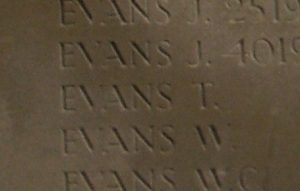
William John Everall, Private, 50735, Cheshire Regiment. William was born at Ludlow on 27 February 1891, the son of Samuel and Hannah Everall. William had worked as a baker prior to enlisting at Hereford into the King’s Shropshire Light Infantry on 7 September 1914. He married Theodora Rebecca Apperley, of the George and Dragon, Knighton on 5 September 1916. On 15 February 1917 William embarked at Southampton for Rouen, and upon his arrival in France was posted to the 4th Battalion, King’s Shropshire Light Infantry before being transferred to the 10th Battalion, Cheshire Regiment, which was attached to 7 Brigade, 2nd Division. In March 1917 the Division followed the German Retreat to the Hindenburg Line, and in April they fought at Arras. Its next major action was at the Battle of Cambrai, and the Division was still in the area in March 1918 when the Germans launched their Spring Offensive on the Somme. The Division was caught up in heavy fighting during the coming weeks, until the offensive stalled, and German attention was diverted elsewhere. The 10th Cheshire’s suffered so many casualties that the battalion was broken up and William was posted to the 9th Cheshire’s, which was attached to 56 Brigade, 19th (Western) Division, which had also seen heavy losses. The 19th Division had also fought at the Lys, before being moved south to the Aisne sector to rebuild. Unfortunately, the Germans launched their final offensive of the war against the Aisne sector in May 1918, and the 19th Division became caught up in desperate fighting. William was killed in action here during heavy fighting around Sarcy on 30 May 1918, aged 25. He has no known grave and is commemorated on the Soissons Memorial, France.
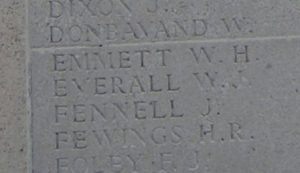
Benjamin Francis, Corporal, 15717, King’s Shropshire Light Infantry. Benjamin was born at Clungunford in 1892, the son of John and Emily Francis. He married Elizabeth Mary Miles at Knighton in 1913 and the couple had three children. Benjamin enlisted at Knighton into the 6th Battalion, King’s Shropshire Light Infantry. The battalion formed at Shrewsbury in September 1914, joining 60 Brigade, 20th (Light) Division at Aldershot and on 22 July 1915 landed at Boulogne and moved to the Fleurbaix Sector for trench familiarisation. When the Battle of Loos was launched on 25 September 1915 the Division fought a diversionary attack towards Fromelles. Later that year it moved north, and fought at the Battle of Mount Sorrel alongside the Canadian Corps. It then fought through the Somme Offensive in 1916 and took part in the advance to the Hindenburg Line in March 1917. Later that year the Division fought at Third Ypres, before moving south in November, to take part in the Battle of Cambrai. The Division remained in the area between Cambrai and St. Quentin over the winter of 1917/18 and was attacked there by the German Spring Offensive of 21 March 1918. The 20th Division was ordered to advance as the severity of the situation became apparent and 60 Brigade took over a line from the Somme to Vaux, where the men began to dig in and wait the onslaught which was coming towards them. By the following afternoon the withdrawing front line troops had fallen back to the line held by the 20th Division and the German attack followed. 60 Brigade, with the 6th KSLI began to withdraw as well and fighting continued throughout the night. Benjamin was killed in action near Canizy on 23 March 1918, aged 23, during another day of heavy fighting. He has no known grave and is commemorated on the Pozieres Memorial, France.
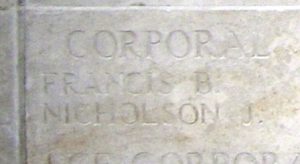
William Ephraim Tudor Goodwin, Private, 63154, King’s Liverpool Regiment. William was born in Hereford in 1881, the son of William and Ellen Goodwin. He married Jane Kerr Clark at Birkenhead in 1909 and by 1911 the couple were living at Broad Street, Knighton, where William worked as a clothier and outfitters assistant. He enlisted at Knighton into the army and was posted to the Labour Company, King’s (Liverpool Regiment). He was serving at Park Hall Camp, Oswestry when he became ill and died of pneumonia at Oswestry Military Hospital on 22 February 1917, aged 35. His remains were brought home for burial in Knighton Cemetery.
Walter Gravener, Private, 56980, Welsh Regiment. Walter was the son of John and Mary Gravener, of Dutlas. He enlisted at Knighton into the Montgomeryshire Yeomanry on 31 May 1915 and on 9 August 1916 arrived in France, where he was attached to the 10th Battalion, Welsh Regiment. The Battalion was attached to 114 Brigade, 38th (Welsh) Division and had just been moved to Hébuterne after a torrid time capturing Mametz Wood. Shortly afterwards the division moved to Ypres, to take up the line at Boesinghe, along the Ieperlee Canal. Walter became ill here during the winter, suffering a spell of tonsillitis, he later contracted trench fever and was returned to England on 14 February 1917. On 11 June 1917 Walter arrived back in France and was sent along with a number of drafts to the 17th Battalion, Welsh Regiment, which was attached to 119 Brigade, 40th (Bantam) Division. He joined the battalion at Villers-Plouich. A few days later the battalion took over positions at Gonnelieu. Walter was probably killed during a night patrol, in the morning of 22 July 1917. The 28-year-old is buried in Honnechy British Cemetery, France.
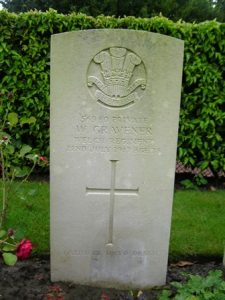
Alfred John Hamar, Lieutenant, Royal Flying Corps. Alfred was born on 17 April 1890, the son of William and Paulina Hamar, of Hill Crest, Knighton. He volunteered to serve in the Royal Flying Corps and gained his Pilots wings at the Military School, Ruislip on 24 January 1916. He joined 55 Squadron, RFC, which was formed at Castle Bromwich on 27 April 1916. It initially operated as a training unit, flying the Avro 504, Royal Aircraft Factory B.E.2 and the Armstrong Whitworth F.K.8, but in January 1917 it changed its role to a day-bomber squadron and re-equipped with the Airco DH4, moving to Fienvillers, France on 6 March 1917 as part of 9th Wing. On 8 April 1917 Alfred was flying his DH4, Serial A2160, over German lines, on a raid of Crown Prince Rupprecht’s HQ at Mons, when it was hit by Anti-Aircraft fire. He managed to get his damaged aircraft back over British lines, but crashed near Amiens whilst attempting to land, seriously wounding Alfred and his Observer, John Adrian Myburgh. Alfred died of his wounds later that day, while Myburgh died a day later. Alfred was 28 years old and was buried with full military honours in St. Pierre Cemetery, Amiens, France. His brother Clarence was killed in a flying accident the following year.
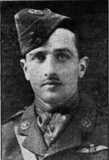
Clarence Richard Hamar, Cadet, 152564, Royal Air Force. Clarence was born on 23 November 1895, the son of William and Paulina Hamar, of Hill Crest, Knighton. In March 1913 Clarence emigrated to America, and set up home at 119, Griswold Street, Detroit. He travelled over the border to enlist into the Royal Air Force in 1918 and was posted to the Canadian Aviation Training Camp, at Beamsville, Ontario. On 3 June 1918 Clarence was flying as an Observer in an aircraft on gunnery practise, when the pilot lost control and their aircraft crashed into the ground, seriously wounding both men. Clarence died the following morning, 4 June 1918, aged 22. He was buried with full military honours in Mount Osborne Cemetery, Beamsville, Ontario.
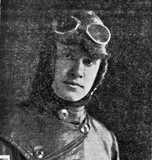
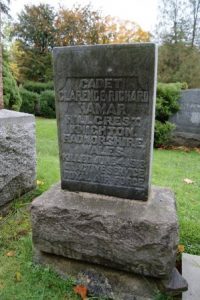
Richard George Hamilton Hamer, Corporal, 3/4092, Hampshire Regiment. Richard was born at Newcastle-on-Tyne in 1897, the son of Moses George Hamer and Elizabeth Hamer. By 1902 the family had moved back to their native Knighton, where Moses died that year. Elizabeth then lived at 26, Exchange Buildings, Knighton. Richard lived at Dorchester prior to the war and enlisted at Southampton into the 3rd Battalion, Hampshire Regiment. He disembarked in France on 27 January 1915 and joined the 1st Battalion, Hampshire Regiment, which was attached to 11 Brigade, 4th Division at Ypres. On 13 May 1915 the 1st Hampshire’s were holding a section of front between Shelltrap Farm and Hampshire Farm when it came under heavy artillery fire. 34 men were killed, 57 wounded and another three men missing. Richard was among the wounded. He was evacuated to the hospital at Bailleul where he died of his wounds on 17 May 1915, aged 18. He is buried in Bailleul Communal Cemetery Extension, France.
Vincent Edward Hammond, Private, 27767, Border Regiment. Vincent was the son of Edward and Bertha Hammond, of Rose Hill, Knighton. He enlisted at Knighton into the Herefordshire Regiment and was then posted to the 3rd Battalion, King’s Shropshire Light Infantry, before being posted to France, where he transferred to the 11th Battalion, Border Regiment, known as the Lonsdales. The battalion was raised by the Earl of Lonsdale and had been in France since 23 November 1915, attached to 97 Brigade, 32nd Division, moving to the Bouzincourt sector. The division saw its first action during the Battle of the Somme, and after suffering heavy casualties moved to the Cambrin sector to rebuild. It then moved back to the Somme sector in the middle of October 1916 and camped at La Vicogne for several weeks before moving back into the line, marching past Black Horse Bridge, through Engelbelmer and Mailly Maillet to the Redan Ridge sector on 17 November, to take over the front line. At 6.10 the following morning, 18 November 1916, the Lonsdales rose from their trenches and attacked the Germans on Redan Ridge. Vincent was killed during the advance that day. He was 26 years old and is buried in Frankfurt Trench British Cemetery, Beaumont-Hamel, France.
Herman Ainley Holroyd, Private, 119748, Machine Gun Corps. Herman was born at Huddersfield in 1885, the son of George and Sarah Ann Holroyd. He married Eliza Harrison in 1908 and by 1911 the family had moved to 11, West Street, Knighton, where Herman worked as a wool manufacturer. He enlisted at Knighton into the Army Service Corps after the outbreak of war and upon being posted to France was transferred to the 47th Battalion, Machine Gun Corps, which was formed on 1 March 1918. The battalion was attached to the 47th (2nd London) Division and was situated near St. Quentin at the time. It was hit hard following the German Spring Offensive on 21 March 1918 and saw heavy fighting over the coming days, during a rearguard action. Herman was wounded during the early days of the offensive, and died of his wounds at the 10th General Hospital, Rouen on 28 March 1918, aged 33. He was buried in St. Sever Cemetery Extension, Rouen, France.
Ernest Edward James, Corporal, 13937, Devonshire Regiment. Ernest was the son of Thomas and Eliza James, of 2, Wilcome Cottage, Knighton. He was lodging at 106 Yniswen Road, Treherbert by 1911 where he had found work as a coal hewer and enlisted at Gorseinon, Swansea, into the 10th Battalion, Devonshire Regiment soon after the outbreak of war. The battalion formed at Exeter before moving to Stockton Camp, Salisbury Plain in 79 Brigade, 26th Division and on 23 September 1915 landed at Boulogne. During November 1915 the Division moved to Salonika, where it remained for the rest of the war. Ernest was killed in Salonika on 10 February 1917, aged 22. He has no known grave and is commemorated on the Doiran Memorial, Greece. His brother, Frank, was killed the previous year.
Frank Osmond James, Private, 17038, Bedfordshire Regiment. Frank was the son of Thomas and Eliza James, of 2, Wilcome Cottage, Knighton. He was living at Swansea at the outbreak of war and enlisted there into the 8th Battalion, Bedfordshire Regiment. The battalion was formed at Bedford before moving to South Downs, near Shoreham in 71 Brigade, 24th Division. Frank landed in France with the battalion on 30 August 1915 and at sometime afterwards transferred to the 6th Battalion, Bedfordshire Regiment, which was attached to 112 Brigade, 37th Division in the Somme sector. On the opening of the Somme offensive on 1 July 1916 the 6th Bedfordshire’s were at Bienvillers and over the coming days moved via Millencourt to the new support line on the Tara to Usna line facing Contalmaison. Frank was killed here on 10 July 1916, aged 19. He has no known grave and is commemorated on the Thiepval Memorial, France.
Raymond William James, Private, 79390, Royal Army Medical Corps. Raymond was born at Kempston, Bedford in 1882, the son of William and Eleanor James. By 1911 the family was living at Old Wine Vaults, Knighton, where they ran their own business. Raymond worked as a nurse prior to enlisting into the Royal Army Medical Corps at Knighton on 27 November 1915. He was posted to Aldershot, but took ill and was sent to the Military Hospital at Tidworth and then to Bulford Hospital, where the problem with his health was noted as being due to syphilis, which had been contracted in Birmingham in 1908. He was discharged from the army as medically unfit on 20 July 1916. He returned to Knighton, where his health continued to fail, and he died on 15 July 1921, aged 38. He was buried in Knighton Cemetery. Although commemorated by the CWGC as a war casualty, Raymond is not commemorated on the Knighton War Memorial.
Lewis Jones, Private, 15789, West Yorkshire Regiment. Lewis was the son of James and Mary Ann Jones, of Russell Lane, Knighton. He enlisted at York into the 9th Battalion, West Yorkshire Regiment following the outbreak of war. The battalion moved to Belton Park, Grantham in 32 Brigade, 11th Division and on 3 July 1915 sailed from Liverpool for Mudros aboard the SS Aquitania, before landing at Suvla Bay, Gallipoli, on 6 August 1915. Weeks of heavy fighting followed for the division. By 20 August the Division had moved forwards to the southern slopes of Chocolate Hill and on the following day assaulted two Turkish trenches before digging in. Lewis was killed in action here on 22 August 1915, aged 37. He has no known grave and is commemorated on the Helles Memorial, Gallipoli.
Page Jones, Private, 23839, King’s Shropshire Light Infantry. Page was born at Knighton on 26 September 1877, the son of Reece and Jane Jones. He worked as a groom at The Plough Inn, Knighton prior to the war. Page enlisted at Knighton into the 3rd Battalion, King’s Shropshire Light Infantry on 13 December 1915 and was sent to Pembroke Dock for training. He was not in khaki for long, as he broke his leg during an accident in training and on 2 May 1916 was discharged from the KSLI as medically unfit. Page returned to Knighton, but his health broke down and he died of pneumonia on 23 January 1917, aged 39. He is buried in Knighton Cemetery. Although commemorated as an official casualty of war by the CWGC, he is not commemorated on the Knighton War Memorial.
William Harold Jones, Private, PLY/16422, Royal Marine Light Infantry. William was born at Leintwardine on 10 August 1896, the son of James and Mary Jones. The family then moved to 9, Mill Green, Knighton. William had worked as a grocers assistant prior to enlisting at Manchester into the Royal Marines on 6 October 1913 and was posted to the Plymouth Battalion, Royal Marine Light Infantry. He served with the battalion, as part of the Royal Naval Division, at Dunkirk and in the Defence of Antwerp early in the war, before the Royal Naval Division embarked for Egypt, in readiness to take part in the forthcoming Gallipoli campaign. William landed with the Division on the shores of Gallipoli on 25 April 1915 and saw much fighting over the coming days. The Division remained on the Peninsula for the campaign. William was killed in action at Gallipoli on 11 June 1915, aged 18. He has no known grave and is commemorated on the Helles Memorial, Gallipoli.
John Ernest Jordan, Private, 27796, Royal Warwickshire Regiment. John was born at Knighton in 1883, the son of William and Elizabeth Jordan. He worked as a bricklayer prior to marrying Minnie Emily Adie in 1912 and the couple made their home at Yew Tree Cottage, Kinsley Road, Knighton. John enlisted at Knighton into the King’s Shropshire Light Infantry after the outbreak of war and was posted to France in 1916, joining the 11th Battalion, Royal Warwickshire Regiment. The battalion was attached to 112 Brigade, 37th Division on the Somme and saw heavy fighting throughout the Somme offensive that year. The battalion spent much of November training at Doullens, before moving back into the line via White City on 14 November 1916, when it attacked Munich and Frankfurt trenches. Three days later the battalion moved into billets at Mailly-Maillet for a brief rest before taking up the line again on 18 November. On 21 November 1916 the battalion found itself in the front line under a heavy German artillery barrage all day. John was killed by this shellfire during the day. The 24-year-old is buried in Serre Road Cemetery, No. 1, France.
John James Langford, Private, 17970, King’s Shropshire Light Infantry. John was born at Knighton in 1884, the son of Francis and Fanny Langford. He worked as a railway labourer and lived at 35, Market Street, Knighton prior to enlisting at Knighton into the King’s Shropshire Light Infantry soon after the outbreak of war. He landed in France on 27 October 1915 and was posted to the 7th Battalion, King’s Shropshire Light Infantry, which was attached to the 3rd Division at Ypres. The Division saw heavy fighting here in 1916 at the Actions of the Bluff, and at the St Eloi Craters. It was then moved south to the Somme, and fought there at the Battle of Albert, and the Battle of Bazentin. The battle was launched at dawn on 14 July 1916 and the 7th KSLI and 8th East Yorks were the assaulting battalions. The objective of the attack was the enemy front trench and support line, running through Bazentin-le-Grand, a distance of about 1,500 yards, however the Germans were waiting and the attackers got caught up in thick barbed wire which had been uncut by the artillery, and the KSLI suffered terrible casualties, only six officers and about 135 other ranks managing to withdraw to safety. John was 32 years old when he was killed that day. He has no known grave and is commemorated on the Thiepval Memorial, France.
John Owen Langslow, Private, 463702, Canadian Infantry. John was born at Clunbury on 1 May 1881, the son of George and Hannah Langslow. The family later resided at The Rookery, Knighton. John emigrated to Canada in about 1905, and moved to Kootenay, where he worked as a labourer. He enlisted at Vernon, British Columbia on 7 August 1915 into the 62nd Overseas Battalion, Canadian Infantry, and sailed from Baltimore for England aboard the SS Baltic on 20 March 1916. Within weeks of arriving back in England, John became ill and was hospitalised for a short while after contracting influenza. On 12 May 1916 he was posted to the 47th Battalion, Canadian Infantry which embarked for France on 10 August 1916, and was wounded on 28 October 1916, suffering a gunshot wound to the face, during the Somme offensive. After recovering from his wound he was posted back to his unit and was hospitalised with trench feet on 22 November. Again he returned to duty, and on 31 March 1917 was wounded again, being sent to No. 2 General Hospital at Le Havre for treatment. On 9 May 1917 he rejoined the battalion near Vimy, and was killed in action there soon afterwards, on 30 May 1917, aged 33. John was buried in Chinook Cemetery, which was situated on the Western side of the main road, some 800 metres North of La Chaudiere, but the cemetery was lost following further fighting in the area and he is now commemorated on a Special Memorial within La Chaudiere Military Cemetery, Vimy, France.
Thomas Edward Phillips, Driver, 213797, Royal Field Artillery. Thomas was the son of Thomas and Martha Phillips, of Rhos-y-Garth, Knighton. He enlisted into the Royal Field Artillery and was posted to Edinburgh with the 6th Reserve Brigade, RFA, which was guarding the docks at Leith. Thomas became ill and died of pneumonia at The Castle Military Hospital, Edinburgh on 2 March 1917, aged 23. His remains were brought home for burial in Knighton Cemetery. Although he is commemorated by the CWGC as an official war casualty, he is not named on the Knighton War Memorial.
Nelson Arthur Pullen, Private, 26388, Manchester Regiment. Nelson was born at Chorlton, Lancashire in 1894, the son of Edward James and Elizabeth Agnes Pullen. By 1901 the family was living at Kington, Herefordshire and by 1911 Nelson was living in Leominster, where he worked as a hairdresser’s assistant. His parents had by then moved to Clock House, Knighton. Nelson joined them at Knighton prior to the war, but travelled to Manchester to enlist into the 16th Battalion, Manchester Regiment. The battalion landed at Boulogne on 6 November 1915 attached to 90 Brigade, 30th Division and moved to the Somme sector. The Division took part in the opening assault of the Battle of the Somme, attacking the German held village of Montauban at dawn on 1 July 1916. The attack was a success, with two artillery guns and over 100 prisoners also taken, but Nelson had been killed during the day. The 22-year-old has no known grave and is commemorated on the Thiepval Memorial, France.
William Alfred Roberts, Corporal, M2/147932, Army Service Corps. William was born at Llangunllo in 1885, the son of William and Elizabeth Roberts. He married Adeline Mary Price in 1907 and the couple lived at Broad Street, Knighton with their son, Albert. He enlisted into the Army Service Corps at Knighton and was posted to the 272nd Horse Transport Company, Army Service Corps, which was attached to the Heavy Artillery Ammunition Column of the Australian Corps. He probably served at Passchendaele with the Australians, before they moved to the Flanders area over the winter. William was wounded in the middle of March 1918 and died of his wounds on 22 March 1918, aged 33. He is buried in Dranoutre Military Cemetery, France.
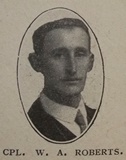
Hector Philip Seabourne, Lance Corporal, 702252, London Regiment. Hector was born in 1896, the son of Thomas Philip and Margaret Seabourne, of Rose Cottage, Knighton. He worked as a shop assistant prior to enlisting at Knighton into the Royal Army Medical Corps on 21 October 1915. On 2 December 1916 Hector was posted to the 2/23rd Battalion, London Regiment, which was attached to 181 Brigade, 60th Division. The division landed at Le Havre on 2 June 1916 and five months later embarked at Marseilles for Salonika. In June 1917 the Division was moved to Egypt, then on 26 May 1918 the 2/23rd Battalion, London Regiment went back to France, joining 21 Brigade, 30th Division. The Division took part in the advance in Flanders from 21 August 1918 onwards. Hector married Beatrice Gore at Liverpool whilst on leave on 27 September 1918, then returned to France. Following the Armistice he returned home, but he took ill, contracting influenza and pneumonia. He died at Venice Street Auxiliary Hospital, Liverpool on 2 February 1919, aged 23. Hector’s remains were brought back home for burial in Knighton Cemetery.
Edward Stedman, Private, 285276, Welsh Regiment. Edward was born in 1885, the son of Edward and Elizabeth Stedman, of Castle Bank, Knighton. He worked as a baker and delivery man in the town prior to enlisting there into the Herefordshire Regiment following the outbreak of war. During October 1916 Edward was mobilised, despite an appeal at the Military Tribunal, and upon completing his training was sent to France, where he was posted to the 9th Battalion, Welsh Regiment. The battalion had seen heavy fighting on the Somme attached to 58 Brigade, 19th (Western) Division, before moving to the Messines sector, taking part in the Battle of Messines Ridge in June 1917. The Division then moved further north and took part in the latter stages of the Passchendaele offensive, before being moved back to the Somme sector over the winter. The Germans launched their Spring Offensive on the Somme on 21 March 1918 and the 19th Division was caught up in the thick of the action, fighting a strategic withdrawal over the coming days. Edward was wounded early in the battle, and was evacuated to the Casualty Clearing Station at Dernancourt where he died of his wounds on 24 March 1918, aged 32. He is buried in Dernancourt Communal Cemetery Extension, France. His brother, Richard, also fell.
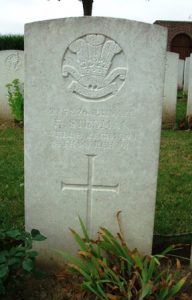
Richard Stedman, Private, 16131, Somerset Light Infantry. Richard was born in 1879, the son of Edward and Elizabeth Stedman, of Castle Bank, Knighton. He worked as a labourer prior to enlisting at Bargoed into the 8th Battalion, Somerset Light Infantry following the outbreak of war. The battalion was attached to 63 Brigade, 21st Division and moved to France on 10 August 1915. Its first experience of battle was calamitous, being in France for only a few days, lengthy forced marches brought it into the reserve for the British assault at Loos, where it was sent into action on 26 September, and suffered over 3,800 casualties for very little gain. The Division rebuilt before moving to the Somme in 1916, and fought at the Battle of Albert on the opening day of the offensive, on 1 July 1916. Richard was killed in action during the heavy fighting that day. He was 36 years old and is commemorated on the Thiepval Memorial, France. His brother Edward was killed later in the war.
William John Turner, Private, 2245, Herefordshire Regiment. William was the illegitimate son of Sarah Jane Turner, of 22, Lower Road, Cwm, Knighton. By 1911 he was living with his Uncle, George Turner, at 19, Hanbury Road, Pontnewydd, where he worked in a steel mill. William enlisted at Hereford into the 1/1st Battalion, Herefordshire Regiment, which was attached to the 53rd (Welsh) Division. The battalion moved to its war station at Pembroke Dock following the outbreak of war and then moved to Oswestry, before finally joining the rest of the Welsh Division at Bedford in May 1915. On 16 July 1915 the Division embarked at Devonport for Gallipoli, landing at Suvla Bay on 9 August 1915. The landing was poorly arranged, with no knowledge of the terrain and very few maps, the Division moved forwards into the bush, coming into contact with the Turks, and chaos reigned over the coming days. William was killed in action at Gallipoli on 11 August 1915, aged 23. He is buried in Lancashire Landing Cemetery, Gallipoli.
William Robert Whittaker, Lieutenant, Herefordshire Regiment. William was born in Stafford on 3 April 1893, the son of William Robert Whittaker and Mary Gertrude Whittaker (nee Robotham). Following the death of his father, his mother moved to Burford House, Knighton, and William worked in the town as a bank clerk. On 15 August 1915 he was commissioned into the Herefordshire Regiment, and embarked for the Mediterranean on 14 July 1916, joining the 1/1st Battalion, Herefordshire Regiment, which was attached to the 53rd (Welsh) Division, on the Suez Canal Defences. The Division was part of the Egyptian Expeditionary Force (EEF), and in August 1916 defeated the Turks at Romani, laying the way open to push forward from the Suez Canal defences to attack the Turkish positions at Gaza. The First Battle of Gaza opened on 26 March 1917, but a thick fog covered the battlefield, making movement difficult for the EEF, but the 53rd Division launched its attack against the south and east of Gaza. By the end of the day, with night falling, the 53rd Division withdrew from its gained positions and on the following morning, 27 March 1917, the Turks counter-attacked. William was killed during the heavy fighting that day. The 23-year-old has no known grave and is commemorated on the Jerusalem Memorial, Israel.
Alfred William Williams, Private, 229347, Monmouthshire Regiment. Alfred was the son of Albert William Williams and Bertha Elizabeth Williams (nee Evans), of Frydd Cottage, Knighton. His father died in 1899 and his mother married John Bell. He worked as a number taker at Cardiff prior to enlisting there into the Monmouthshire Regiment on 2 December 1915. He was mobilised on 28 February 1917 and was posted to France, joining the 1st Battalion, Monmouthshire Regiment on 19 November 1917. The battalion was by then the Pioneer Battalion to the 46th (North Midland) Division. During 1918 the Division took part in the Advance in Flanders, and then moved south, where it was tasked with the breaking of the Hindenburg Line. The Division fought at the Battle of the St Quentin Canal at the end of September, where it forced the crossing of the St Quentin Canal at Riqueval. The mighty Hindenburg Line had now been breached, and the Division helped drive the Germans back towards their frontier. Alfred was killed on the opening day of the Battle of Cambrai, when the 1st Monmouth’s assaulted the German held village of Sequehart on 8 October 1918, aged 21. He is buried in Sequehart British Cemetery, No. 1, France.
Arthur Stanley Williams, Private, 16136, King’s Shropshire Light Infantry. Arthur was the son of John and Mary Williams, of 1, Castle Bank, Knighton. He enlisted at Shrewsbury into the 5th Battalion, King’s Shropshire Light Infantry. The battalion was raised in Shrewsbury in August, joining 42 Brigade, 14th (Light) Division at Aldershot and landed at Boulogne on 20 May 1915. The Division was to see its first action during the Action of Hooge, where the Division was the first to be attacked by the German use of flamethrowers. On 25 September 1915 the Battle of Loos was launched, to the south, so the 14th Division made a diversionary attack on the same day, during the Second attack on Bellewaarde. Heavy casualties were suffered by the 5th KSLI during the attack that day, with almost 450 men killed, wounded or missing. Among the dead was 21-year-old Arthur. He has no known grave and is commemorated on the Menin Gate Memorial, Ypres. Although raised in Knighton, Stanley is not commemorated on the Knighton War Memorial.
William George Williams, Gunner, 103187, Royal Garrison Artillery. William was the son of John and Mary Williams, of 1, Castle Bank, Knighton. He enlisted at Knighton into the Royal Garrison Artillery, and was posted to France with the 143rd Siege Battery, Royal Garrison Artillery, arriving at Boulogne on 16 August 1916. The battery was equipped with four 9.2” howitzers, and served on the Western Front until after the Armistice, when the men were demobilised and sent home. William survived the war but died at Knighton on 21 December 1919, aged 29. He is buried in Knighton Cemetery. Although commemorated as an official war casualty by the CWGC, William is not named on the Knighton War Memorial.
World War Two, 1939-1945
Reginald Jenkins Baker, Leading Aircraftman, 1656332, Royal Air Force Volunteer Reserve. Reginald was born at Knighton on 8 November 1905, the illegitimate son of Eliza Whittall. He was brought up by Sydney and Mary Ann Hughes, at 3, Mill Green, Knighton. Reginald enlisted into the Royal Air Force Volunteer Reserve following the outbreak of war and was posted to India. He died at Ranchi on 13 August 1944, aged 38, and is buried in Ranchi War Cemetery, India.
Ronald Alfred William Beaumont, DFC, Flight Lieutenant, 162506, Royal Air Force Volunteer Reserve. Ronald was born on 14 November 1919, the son of Josiah Samuel James Beaumont and Gladys Louisa Beaumont (nee Cook), of 5, High Street, Knighton. He enlisted into the Royal Air Force Volunteer Reserve and trained an engineer at Tangmere prior to the war. He then trained as a Pilot before being posted to 57 Squadron, RAF, which was a heavy bomber squadron, based at RAF East Kirkby. On the night of 21 June 1944 Ronald took off from East Kirkby, flying Lancaster I, Serial NN696, which was part of a large force ordered to bomb the synthetic oil plant at Wesseling. Early the following morning, 22 June 1944, the Lancaster was attacked by a German night-fighter and crashed West of Geilenkirchen, with the loss of all seven of her crew. Ronald and four of his crew were initially buried in Havert Cemetery, but after the war their graves were exhumed and reburied in Rheinberg War Cemetery, Germany. The other two crewmen have no known graves and are commemorated on the Runnymede Memorial, Surrey. Ronald was posthumously awarded the Distinguished Flying Cross.
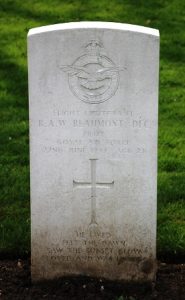
Peter Norman Ellis, Sergeant, 1817434, Royal Air Force Volunteer Reserve. Peter was born in Islington in 1924, the son of Norman Thomas Henry Ellis, a market gardener, and Aline Greta Ellis (nee Wilby). The family came to live in Knighton just after the outbreak of war. Peter enlisted into the Royal Air Force Volunteer Reserve and trained as an Air Gunner before being posted to 161 Squadron, Royal Air Force, which was based at RAF Tempsford in Bedfordshire. On 14 February 1945 Peter was flying aboard a Short Stirling IV, Serial LK236 on a short training flight, in poor visibility, when the Stirling was hit by a USAAF P-51 Mustang and both aircraft crashed into the ground near Potton, Bedfordshire, killing all of the crewmen aboard the Stirling and the pilot of the Mustang, Thomas Kiley. Peter was just 20 years old when he was killed in the crash and was buried in Cambridge City Cemetery.
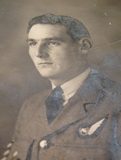
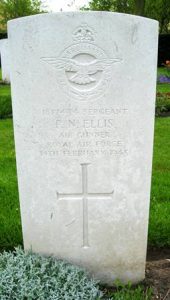
Royston Charles Asply Evans, Private, 14672053, Royal Inniskilling Fusiliers. Royston was the son of John Evans and Gladys Mary Evans (nee Aspley), of 7, Frydd Terrace, Knighton. His mother had lost her brother, Charles Joseph Aspley, in WW1. Royston enlisted into the army and was posted to the 5th Battalion, Royal Inniskilling Fusiliers. Royston was probably attached to another unit, as he was killed during D-Day, on 6 June 1944, aged 19. His battalion did not serve overseas, so he was most likely attached to another unit. Royston was buried on the battlefield, along with another Fusilier, Victor Ainslow Cooke, but on 15 November 1944 their graves were exhumed and both men were re-buried in Bayeux War Cemetery, France.
Jack Royston Hamar, DFC, Pilot Officer, 70898, Royal Air Force. Jack was born on 21 December 1914, the son of Arthur Thomas Hamer and Sarah Annie Hamar (nee Gregg), of Hill Crest, Knighton. He enlisted into the Royal Air Force in 1938 and trained as a pilot before being posted to 151 Squadron, RAF. He served in France before the evacuation to Dunkirk, scoring four victories and upon the Squadrons return to Manston, he continued to down several more German aircraft. He was killed on 24 July 1940 whilst flying Hurricane P3316, when he stalled the aircraft whilst attempting to land at North Weald and crashed, mortally wounding him. His remains were brought home for burial in Knighton Cemetery. He was posthumously awarded the Distinguished Flying Cross. He had lost two uncles, Alfred John Hamar and Clarence Richard Hamar, during WW1.
James Gilbert Jones, Trooper, 14222659, 5th Royal Inniskilling Dragoon Guards. James was the son of William John Jones and Ellen Jones (nee Knowles), of 20, West Street, Knighton. He enlisted into the army and was posted to the 5th Royal Inniskilling Dragoon Guards, which was an armoured unit attached to the Royal Armoured Corps. The 5th Dragoon Guards landed in Normandy a month after the initial D-Day landings of 6 June, and joined the 22nd Armoured Brigade, 7th Armoured Division. James was killed during fighting around Mont Pincon on 1 August 1944. He was 21 years old and is buried in Hottot-Les-Bagues War Cemetery, France.
Philip Albert Swancott Lane, Lieutenant, Royal Navy. Patrick was the son of Albert Lane and Edith Gertrude Lane (nee Swancott), of 23, West Street, Knighton. He enlisted into the Royal Navy prior to the war and whilst based at Portsmouth married Alma Doreen Smith, at Portsmouth, in 1941. Philip served aboard the sloop HMS Egret. She had been launched in 1938 and served with the Western Approaches Command from 1940. On 27 August 1943, Egret was on an anti-submarine patrol in the Bay of Biscay, along with the rest of the 1st Support Group, when the group was attacked by a squadron of eighteen Dornier Do 217, armed with the new Henschel glide bombs. Egret was sunk with the loss of all of her crew of 198 men, becoming the first ship ever to be sunk by a guided missile. Philip was 24 years old when he was killed that day, and is commemorated on the Portsmouth Naval Memorial, Hampshire.
Derrick Gordon Masters, Pilot Officer, 143873, Royal Air Force Volunteer Reserve. Derrick was the son of Charles Albert Masters and Dorothy Gertrude Masters (nee Styles), of Fairholme, Knighton. He enlisted into the Royal Air Force Volunteer Reserve and trained as a Navigator/ Wireless Operator before being posted to 488 (R.N.Z.A.F.) Squadron, RAF. On 2 April 1943 he was flying aboard a Bristol Beaufighter VIf, Serial X8263, on manoeuvres in Ayrshire, when the aircraft crashed into high ground near Balig Farm, Ayr, killing Derrick and his pilot, Rupert O’Gara. Derrick was 21 years old, and his remains, along with those of Rupert, were brought back home for burial in Knighton Cemetery.
Rupert Clark O’Gara, Pilot Officer, 414327, Royal New Zealand Air Force. Rupert was born in Auckland, New Zealand in 1920. He volunteered into the Royal New Zealand Air Force at the start of the war, and learned to fly under the Empire Air Training Scheme in Canada, prior to being sent to the UK, to join 488 Squadron, Royal New Zealand Air Force, at RAF Ayr. On 2 April 1943 he was flying a Bristol Beaufighter VIf, Serial X8263, on manoeuvres in Ayrshire, when the aircraft crashed into high ground near Balig Farm, Ayr, killing Rupert and his Navigator, Derrick Masters. Rupert’s remains were brought to Knighton to be buried alongside his friend and crewman Derrick in Knighton Cemetery. Rupert is not commemorated on the Knighton War Memorial.
Ernest Henry Reece, Private, 852962, Royal Artillery. Ernest was the son of William Reece and May Reece (nee Woodhouse), of Knighton. He married Edith Mae Bowen at Knighton in 1938. Ernest enlisted into the Royal Artillery at the start of the war, and was posted to 113 Field Regiment, RA, which was attached to the 56th Division. He was posted to Pembrokeshire with the unit and was knocked down and killed by a motor car at Bulls Hill, Haverfordwest on 29 March 1940, aged 24. His remains were brought home for burial in Knighton Cemetery. His brother, Heber, was killed in Syria in 1943.
Heber John Reece, Private, 925343, Royal Artillery. Heber was the son of William Reece and May Reece (nee Woodhouse), of Knighton. Like his brother Ernest, he enlisted into the Royal Artillery following the outbreak of war and was posted to Syria. Heber died in Damascus on 20 April 1943, aged 23, and is buried in Damascus Commonwealth War Cemetery, Syria. His brother Ernest was killed in an accident in 1940.
P. W. Samuels, Private. This man cannot presently be identified.
George Edward Tomlinson, Ordinary Telegraphist, D/JX 211907, Royal Navy. George was the son of Edward and Annie Beatrice Daisy Tomlinson (nee Stuttle), of 9, Victoria Road, Knighton. He enlisted into the Royal Navy, and was posted aboard the Dido-class light cruiser HMS Hermione. She took part in the hunt for the German pocket battleship Bismarck and the heavy cruiser Prinz Eugen, before joining Force H, at Gibraltar. On 17 June 1942, Hermione was on patrol in the Mediterranean, when she was torpedoed and sunk by the German submarine U-205, with the loss of 87 lives. George was 26 years old when he died that day, and is commemorated on the Plymouth Naval Memorial, Devon.
Sydney Arthur Turner, Gunner, 848831, Royal Artillery. Sydney was the son of William Turner and Jane Turner (nee Williams), of 34, Market Street, Knighton. He enlisted into the Royal Artillery and was posted to the 3rd Field Regiment, Royal Artillery. The regiment was in India at the start of the war, then saw action in Persia before moving to North Africa in 1942. Following the surrender of Rommel’s Afrika Korps, the regiment embarked for service in Italy, landing in Taranto with the 8th (Indian) Division in September 1943. Sydney was killed in Italy on 17 November 1943, aged 24. He is buried in Sangro River War Cemetery, Italy.
Frank Gordon Wagstaff, Trooper, 14339636, 24th Lancers. Frank was born in Basingstoke on 3 September 1913, the son of Edgar William Wagstaff and Blanche Eva Wagstaff (nee Bowerman). The family moved to Shrewsbury prior to the war and Frank married Joan Williams in 1939, before the couple settled at Wayside, Presteigne Road, Knighton. Frank enlisted into the 24th Lancers following the outbreak of war. The regiment was raised in December 1940 and was assigned to the 8th Armoured Brigade on 8 February 1944, in readiness for the Normandy landings. The regiment landed on Gold Beach on 7 June 1944, in the second wave, supporting the 50th (Northumbrian) Division, equipped with Sherman tanks. Frank was killed during heavy fighting around Putot-en-Bessin on 8 June 1944, aged 30. He is buried in Bayeux War Cemetery, France.
William Thomas Ward, Private, 14362313, Suffolk Regiment. William was the son of William Ward, and of Florence Ward (nee Deakin), of Burgage Farm, Wigmore, Herefordshire. He resided in Knighton prior to enlisting into the army and was posted to the Far East with the 2nd Battalion, Suffolk Regiment. The battalion was serving in India at the outbreak of the war, then in 1943 transferred to the 123rd Indian Infantry Brigade, 5th (Indian) Infantry Division and took part in the Burma Campaign. William died in Burma on 22 December 1943, aged 19. He has no known grave and is commemorated on the Rangoon Memorial, Myanmar.
Denis James Thomas Watts, Sergeant, 651006, Royal Air Force. Denis was the son of Ernest Thomas Watts and of Lilian Watts, of Lower Cwm, Knighton, Radnor. He enlisted into the Royal Air Force and trained as an Air Gunner, before being posted to 70 Operational Training Unit. Denis was killed when flying aboard a Martin Baltimore III, Serial AH114, when it crashed into the Great Bitter Lake just after taking off for a training flight in Egypt on 17 August 1944. Denis was 22 years old when he died in the crash, and is buried in Fayid War Cemetery, Egypt.